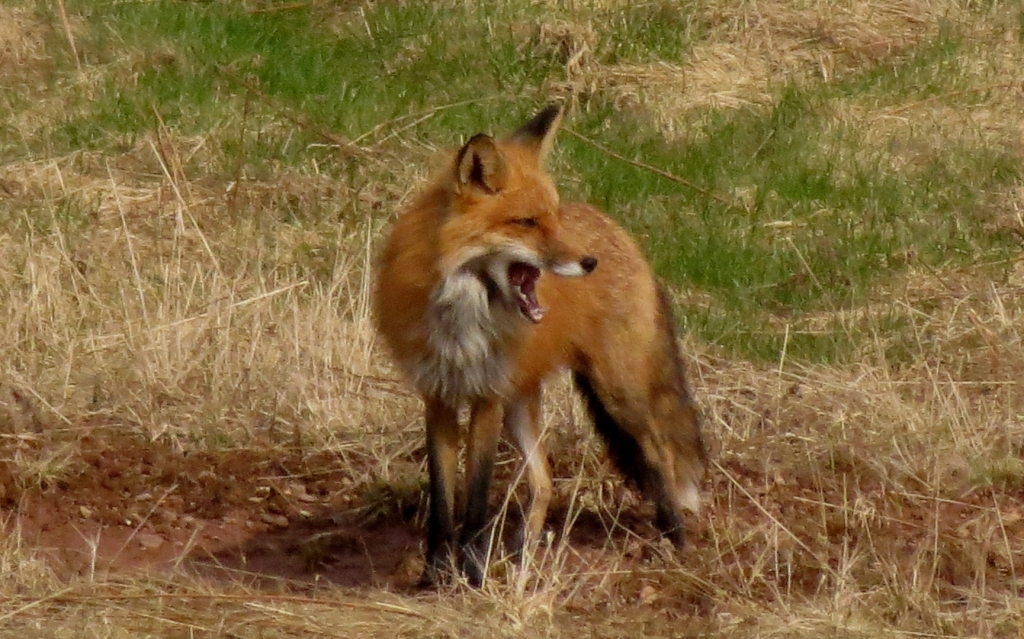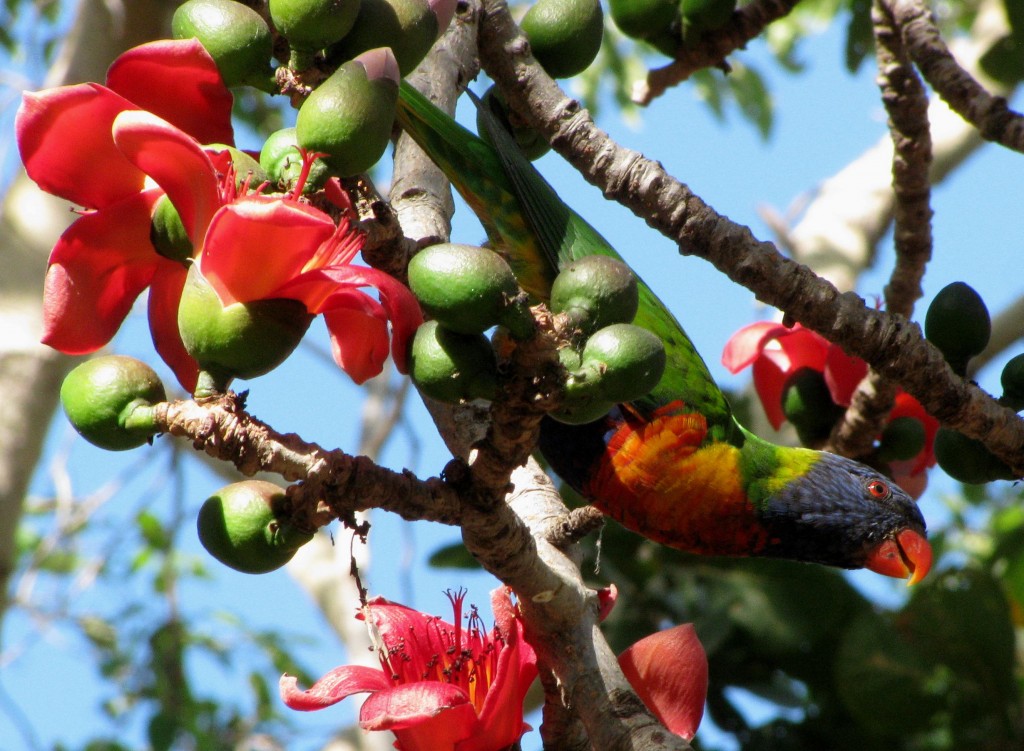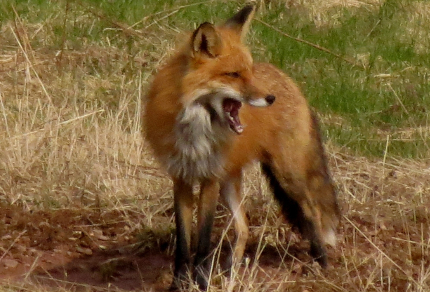Ground mist hung over the Townsville Golf Club and riverside meadows as I cycled to the Ross River Bush Gardens after dawn to join members of the Townsville Region Bird Observers Club for their monthly survey of the gardens’ avian residents. Soft-looking cloud clung to the crown of Mount Stuart above fractured pink cliffs lit by morning sun, eliciting comments from more than one birder. We followed our usual elliptical route along the parkway path above the gardens, and then back through the gardens along the river, pausing to attempt to identify and count every bird seen. I learned that the man-made island I once scrambled over dead logs to reach is named Baza Island (after a pair of Pacific bazas or crested hawks that nested in the gardens several years ago), and that a spiky-barked tree bearing large, stunningly beautiful red flowers I’ve frequently admired is a bombax tree. I observed no new bird species, but soaked up a gorgeous close-up view of a brush cuckoo, as well as the animated conversations of birders who love to talk about birds.
Late in the morning, I caught the end of ABC Radio National’s Bush Telegraph program, which featured an interview with Mark Antos, an environmental scientist working with Parks Victoria. The brief clip was titled “Foxes on Film” and referred to efforts being made by Parks Victoria to monitor populations of red foxes.1 Introduced to Australia from Europe in the mid-1850’s for sport hunting, red foxes – which are highly mobile and adaptable predators – have spread throughout all of Australia except for the far north and Tasmania, although evidence of foxes in Tassie came to light in 2001.2 (In March of this year, Vilis and I saw highway notices in Tassie requesting motorists to report red fox sightings.)

Red Fox (© Magi Nams)
Versatile in their feeding habits, red foxes are now regarded as a major factor in the decline of populations of native Australian animals as varied as the green turtle, night parrot, and bridled nail-tail wallaby2, and are potentially the single factor resulting in the extinction of dozens of species of native small mammals.3 Poison baits are generally used to kill red foxes,2 and the “Foxes on Film” clip explained how motion detection cameras such as those Vilis and Janis helped set up in Western Australia are being used to determine the effectiveness of the baiting program in Great Otway National Park in Victoria, where endangered native species such as the long-nosed and southern brown bandicoots have been decimated by foxes.1 The results? The cameras, which are triggered by movement or, in the case of “more sophisticated” equipment, by the heat generated by a passing animal, have recorded scores of still photographs and appear to indicate that the fox control measures are working.1 In areas with no bait poisoning, fox numbers are up, and in areas with poisoning, they’re down.1 That’s good news for small and medium-sized native animals.
Australia, like New Zealand, has suffered great hardship due to the lack of foresight of its European settlers, some of whom attempted to recreate England on a landmass bearing no resemblance whatsoever to England. Thus came the invasive gorse and Scotch broom (Vilis and I observed some of each northeast of Melbourne and in Tasmania), and thus came the red foxes and European rabbits, both of which wreak havoc in native Australian ecosystems. The results of the foxes’ introduction I’ve described above. Rabbits, which were introduced for sport hunting in 1859, did what rabbits do, resulting in their population reaching an estimated 600 million by 1950.4 During the nearly 100 years of their uncontrolled spread, they destroyed vegetation and competed with native animals and livestock for food.
Then, in an example of biological control familiar to us all, Australia’s national science agency, the CSIRO, introduced the myxoma virus to the continent in 1950 in an attempt to kill the rabbits and reverse the devastation they had caused.4 The virus caused a fatal disease known as myxomatosis and killed 99% of the rabbits within a few years, making this biological control of a mammalian pest a world first.4 Of course, the small proportion of rabbits naturally immune to the virus went on to reproduce, necessitating the introduction of a new virus, the rabbit haemorrhagic disease virus or calicivirus in 1995, which again reduced numbers drastically but did not completely eliminate the long-eared pests.4 So, Australia struggles on with both its foxes and its rabbits.
Since this is National Science Week in Australia, I’ll highlight another of the CSIRO’s successes in the battle against invasive species. This time, the culprit is the prickly pear cactus, which was introduced to Australia by settlers as a hedge and pot plant,5 but which escaped and, like both the red foxes and European rabbits, spread rapidly. By the 1920’s, the cactus dominated 24 million hectares of farmland5 and was the biggest weed problem in northeastern Australia, rendering large areas of northern New South Wales and central Queensland agriculturally unusable.6 In 1926, CSIRO introduced larvae of a South American cactus moth, Cactoblastis cactorum, to the infested regions, and – voila! – within ten years, the vast expanses of cactus had disappeared or dwindled to rotting masses.5 Prickly pear still exists in Australia – Vilis, Janis, and I have seen it – but in greatly-reduced abundance that rarely causes a severe economic impact to farming.6
Today’s birds: rainbow lorikeets, white-throated honeyeaters, peaceful doves, masked lapwings, magpie-larks, straw-necked ibises, Australian white ibises, blue-faced honeyeater, white-gaped honeyeaters, brown honeyeaters, mynas, Australian magpie, yellow honeyeaters, brush cuckoos, white-bellied cuckoo-shrike, olive-backed oriole, spangled drongos, helmeted friarbirds, leaden flycatcher (f), intermediate egret, anhingas, comb-crested jacana, welcome swallows, forest kingfisher, rainbow bee-eaters, great bowerbirds, white-breasted woodswallows, nutmeg mannikins.

Rainbow Lorikeet Foraging in Bombax Tree (© Magi Nams)
References:
1. ABC Radio National, Bush Telegraph. Foxes on Film. Wednesday, August 18, 2010, 11:43 a.m. Accessed 18-Aug-2010. http://www.abc.net.au/rn/bushtelegraph/
2. Australian Government, Department of the Environment, Water, Heritage and the Arts. Invasive species: Invasive species fact sheet: European red fox (Vulpes vulpes). Updated 16-Feb-2009. Accessed 18-Aug-2010. http://www.environment.gov.au/biodiversity/invasive/publications/european-red-fox.html
3. Columbia University, Invasion Biology Introduced Species Summary Project: European Red Fox (Vulpes vulpes). http://www.columbia.edu/itc/cerc/danoff-burg/invasion_bio/inv_spp_summ/Vulpes_vulpes.htm
4. CSIRO. Explore CSIRO: Feature Article: The virus that stunned Australia’s rabbits. Updated 18-Aug-2005. Accessed 18-Aug-2010. http://www.csiro.au/science/MyxomatosisHistory.html
5. CSIRO. Explore CSIRO: CSIRO’s history: the 1920’s. Updated 22-Mar-2006. Accessed 18-Aug-2010. http://www.csiro.au/resources/CSIROHistory1920s.html
6. Australian Weed Committee. National Weed Strategy: Weed Idenification: Prickly Pear. Accessed 18-Aug-2010. http://www.weeds.org.au/cgi-bin/weedident.cgi?tpl=plant.tpl&ibra=all&card=S12


